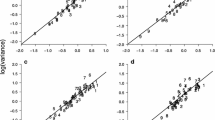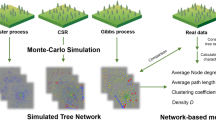Abstract
The size of a sampling unit has a critical effect on our perception of ecological phenomena; it influences the variance and correlation structure estimates of the data. Classical statistical theory works well to predict the changes in variance when there is no autocorrelation structure, but it is not applicable when the data are spatially autocorrelated. Geostatistical theory, on the other hand, uses analytical relationships to predict the variance and autocorrelation structure that would be observed if a survey was conducted using sampling units of a different size. To test the geostatistical predictions, we used information about individual tree locations in the tropical rain forest of the Pasoh Reserve, Malaysia. This allowed us to simulate and compare various sampling designs. The original data were reorganised into three artificial data sets, computing tree densities (number of trees per square meter in each quadrat) corresponding to three quadrat sizes (5×5, 10×10 and 20×20 m(2)). Based upon the 5×5 m(2) data set, the spatial structure was modelled using a random component (nugget effect) plus an exponential model for the spatially structured component. Using the within-quadrat variances inferred from the variogram model, the change of support relationships predicted the spatial autocorrelation structure and new variances corresponding to 10×10 m(2) and 20×20 m(2) quadrats. The theoretical and empirical results agreed closely, while the classical approach would have largely underestimated the variance. As quadrat size increases, the range of the autocorrelation model increases, while the variance and proportion of noise in the data decrease. Large quadrats filter out the spatial variation occurring at scales smaller than the size of their sampling units, thus increasing the proportion of spatially structured component with range larger than the size of the sampling units.
Similar content being viewed by others
References
Borcard, D., Legendre, P. & Drapeau, P. 1992. Partialling out the spatial component of ecological variation. Ecology 73: 1045- 1055.
Borcard, D. & Legendre P. 1994. Environmental control and spatial structure in ecological communities, with an example on Oribatid mites (Acari, Oribatei). Environ. and Ecol. Statistics 1: 37-53.
Buckland, S. T., & Elston, D. A. 1993. Empirical models for the spatial distribution of wildlife. J. Appl. Ecol. 30: 478-495.
Carlile, D. W., Skalski, J. R.,. Barker, J. E., Thomas, J. M. & Cullinan, V. I. 1989. Determination of ecological scale. Landscape Ecol. 2: 203-213.
Cochran, W. G. 1977. Sampling techniques. 3rd edition. JohnWiley and Sons, New York, USA.
Cressie, N. A. C. 1993. Statistics for spatial data. Revised edition. John Wiley & Sons. New York, USA.
David, M. 1977. Geostatistical ore reserve estimation. Elsevier, Amsterdam, The Netherlands.
Greig-Smith, P. 1952. The use of random and contiguous quadrats in the study of structure in plant communities. Ann. Bot., New Series 16: 293-316.
He, F., Legendre, P., Bellehumeur, C. & LaFrankie, J. V. 1994. Diversity pattern and spatial scale: a study of a tropical rain forest of Malaysia. Envir. Ecol. Statistics 1: 265-286.
Isaaks, E. & Srivastava, R. M. 1989. An introduction to applied geostatistics. Oxford University Press, New York, USA.
Journel, A. G. & Huijbregts, C. J. 1978. Mining geostatistics. Academic Press, London, England.
Kenkel, N. C. 1988. Spectral analysis of hummock-hollow pattern in a weakly minerotrophic mire. Vegetatio 78: 45-52.
Kochummen, K. M.,. LaFrankie, J. V. & Manokaran, N. 1991. Floristic composition of Pasoh forest Reserve, a lowland rain forest in Peninsular Malaysia. J. Trop. For. Sci. 3: 1-13.
Kratochvil, B., Wallace, D. & Taylor, J. K. 1984. Sampling for chemical analysis. Anal. Chem. 56: 113R-129R.
Legendre, P. & Fortin, M-J. 1989. Spatial pattern and ecological analysis. Vegetatio 80: 107-138.
Levin, S. 1989. Challenges in the development of a theory of ecosystem structure and function. pp. 242-255. In: Roughgarden, J., May, R. M. & Levin, S. A. (eds), Perspectives in Ecological Theory. Princeton University Press, Princeton, New Jersey, USA.
Levin, S. 1992. The problem of pattern and scale in ecology. Ecology 73: 1943-1967.
Ludwig, J. A. & Goodall, D.W. 1978. A comparison of paired-with blocked-quadrat variance methods for the analysis of spatial pattern. Vegetatio 38: 49-59.
Marceau, D. J., Gratton, D. J., Fournier, R. A. & Fortin, J-P. 1994. Remote sensing and the measurement of geographical entities in a forested environment. 2. The optimal spatial resolution. Remote Sensing Envir. 49: 105-117.
Matheron, G. 1984. Estimating and choosing. Springer-Verlag, Berlin.
Palmer, M. W. 1988. Fractal geometry: a tool for describing spatial patterns of plant communities. Vegetatio 75: 91-102.
Patil, G. P. & Stiteler, W. M. 1974. Concepts of aggregation and their quantification: a critical review with some new results and applications. Res. Pop. Ecol. 15: 238-254.
Rossi, R. E., Mulla, D. J., Journel, A. G. & Franz, E. H. 1992. Geostatistical tools for modeling and interpreting ecological spatial dependence. Ecol. Monogr. 62: 277-314.
Sawyer, A. J. 1989. Inconstancy of Taylor's b: simulated sampling with different quadrat sizes and spatial distribution. Res. Popu. Ecol. 31: 11-24.
Taylor, L. R., Perry, J. N., Woiwod, I. P. & Taylor, R. A. J. 1988. Specificity of the spatial power-law exponent in ecology and agriculture. Nature 332: 721-722.
Thompson, S. K. 1992. Sampling. John Wiley and Sons. New York, USA.
Ver Hoef, J. M., Cressie, N. A. C. & Glenn-Lewin, D. C. 1993. Spatial models for spatial statistics: some unification. J. Vegetation Sci. 4: 441-452.
Wiens, J. A. 1989. Spatial scaling in ecology. Functional Ecol. 3: 385-397.
Author information
Authors and Affiliations
Rights and permissions
About this article
Cite this article
Bellehumeur, C., Legendre, P. & Marcotte, D. Variance and spatial scales in a tropical rain forest: changing the size of sampling units. Plant Ecology 130, 89–98 (1997). https://doi.org/10.1023/A:1009763830908
Issue Date:
DOI: https://doi.org/10.1023/A:1009763830908




